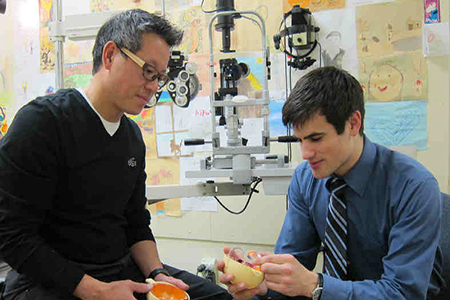Most high school students know that STEM is the acronym for science, technology, engineering and math. But knowing what STEM stands for isn’t the same as knowing what it could mean for you in terms of a career, so we’re breaking it down for you.
Why Do We Need More People Pursuing STEM Careers?
Frederick Driscoll, dean of the College of Engineering and Technology at Wentworth Institute of Technology (MA), points out that STEM education is behind everything that is manufactured. “From the cars we drive to the computers we use, from lifesaving medical technology to the cellphones we all carry around with us, STEM education is the future,” Driscoll says. “As science and technology advance, we’ll need people with strong STEM backgrounds leading the way.”
Beth Wolfe, director of recruitment for Marshall University (WV), agrees: “Today’s society requires technologically savvy problem-solvers to provide the technology, infrastructure and health care demanded by our growing global population. We utilize the products of STEM degree holders virtually every minute of every day, and that is only going to increase with new developments and discoveries.”
Toni Munguia, director of recruitment, retention and diversity in the Purdue Polytechnic Institute at Purdue University (IN), says economic reports predict a shortage of people qualified for the STEM workforce. “The United States is behind other countries in producing STEM graduates,” Munguia says. “This shortage is leading to high job placement and salaries in the STEM fields for students.”
What are Some of the More Popular STEM Majors?
According to Driscoll, Wentworth offers 12 STEM-related majors: applied mathematics, biological engineering, biomedical engineering, civil engineering, computer engineering, computer information systems, computer networking, computer science, electrical engineering, electromechanical engineering, interdisciplinary engineering and mechanical engineering.
Of those, Driscoll says mechanical engineering is very popular at Wentworth, which mirrors the national trend. “Our biomedical engineering program has a large enrollment, half of which is usually women,” he says. “Computer engineering programs, similar to computer science programs, have seen significant enrollment increases in the past three years.”
Although engineering degrees are also popular at Marshall, Wolfe says the science and technology
sides of STEM programs are also in demand. “Biology and chemistry degrees have long been popular as preparation for professional medical schools,” Wolfe says. “Degrees in computer science and other technology fields (such as digital forensics) have been growing rapidly over the past decade.”
Digital forensics is also garnering a lot of interest at Purdue Polytechnic. “The STEM careers that increased in popularity include robotics, animation, gaming, user experience (UX), data visualization, and anything around cyberforensics and security,” Munguia says.
Charlie Wiseman, Department Chair of Computer Science and Networking at Wentworth, adds that the school is seeing some interesting trends in the computer science field, including cybersecurity, internet of things (e.g., smart devices in the home), wearable devices and virtual reality.
In fall 2017, students at Stanford will be able to major in aeronautics and astronautics as undergrads. It’s a growing field of interest, as is reflected in the two student clubs: Stanford Unmanned Aerial Vehicle Enthusiasts, Engineers and Entrepreneurs has about 150 members, while Stanford Student Space Initiative has about 200.
What are the stem fields?
- Biological sciences (except medicine and other clinical fields)
- Physical sciences
- Mathematical sciences
- Computer and information sciences
- Geosciences
- Engineering
- Technology areas associated with the preceding fields
- Social and behavioral sciences
- Education
How Many Years of College Do Most STEM Students Complete?
“Our average time to degree … is four and a half years,” says Jacqueline Brown, director of advising at Purdue Polytechnic Institute. “We often see an extension over four years due to students’ choice to pursue co-ops, double majors, semester-long internships and study abroad experiences.”
Driscoll says that most of Wentworth’s STEM-related programs take four years, with two exceptions: Electromechanical engineering is a five-year program, and applied mathematics is a three-year program with a four-year option.
Many Marshall students also complete their degree in four years. “We have four-year graduation plans for all our STEM majors,” Wolfe says, “but students may also want to explore the possibility of 3-2 programs in which they can earn their bachelor’s and master’s degrees in five years.”
How Much Is a Typical Starting Salary for STEM Graduates?
Wolfe says factors include the specific field the student pursues, whether they enter the private or public sector, and the general economy of the area in which they live. “That said, it’s not uncommon for our engineering graduates to have job offers starting at $60,000 when they graduate,” she says.
Munguia sees similar starting salaries for Polytechnic graduates at Purdue, specifically in computing. “We tend to see our computing majors placed between $50,000 and $70,000, but some are as high as $100,000,” she says.
What Can I Do Now to Prepare to Pursue a STEM Degree in College?
Jennifer Albert, director of the STEM Center of Excellence at The Citadel (SC), points out that there are many programs currently geared toward attracting more underrepresented students, such as women and minorities, into STEM fields.
“For example, the National Science Foundation and the College Board have created a new [Advanced Placement (AP)] course called Computer Science Principles geared specifically at broadening participation,” Albert says. “Another course, called Exploring Computer Science, is geared for upper middle school or high school and has that similar goal. Additionally, scholarships and grants are being offered for students and institutions interested in broadening participation.”
Wolfe says the best thing students can do while in high school is to challenge themselves as much as possible in their science and math courses. “If your school offers AP, [International Baccalaureate] or dual credit courses in the STEM areas, enroll in these classes,” she advises.
Munguia adds that students can prepare for a STEM degree through their high school course selections and extracurricular activities. “They can shadow a professional working in a STEM discipline; participate in STEM-focused competition teams, such as robotics or computing hackathons; and pursue rigorous course work,” Munguia says. High school students can also take advantage of programs in the Polytechnic and at Purdue. “We host a range of summer camps tailored to a specific topic, such as cybersecurity, or to a specific demographic, such as young women. We also have supplemental programming for our new students to participate in a summer bridge program between their senior year of high school and first year in the Polytechnic.”
At Wentworth, faculty, the admissions staff and the Society of Women Engineers participate in events focused on encouraging junior and senior high school girls to get excited about STEM careers. This summer, Wentworth will offer a RAMP High School Girls Program. The six-week program is for rising high school juniors and seniors to introduce them to the STEM fields.
“STEM education is built on mathematics and science and their applications to engineering and technology so one can analyze and design solutions for real-world problems and improve society,” Driscoll says. “Therefore, high school students should be willing to study these topics and be curious about how things work and how they would improve them. They should realize that just about everything they touch that has been manufactured has some form of STEM education behind it.”
If science, technology, engineering or mathematics appeals to you and you want to earn a great starting salary, consider enrolling in a pre-college STEM program to confirm your interest. The worst-case scenario is that you find out you don’t want to pursue a STEM degree. The best-case scenario is that you love it—and gain some experience for your college applications!



